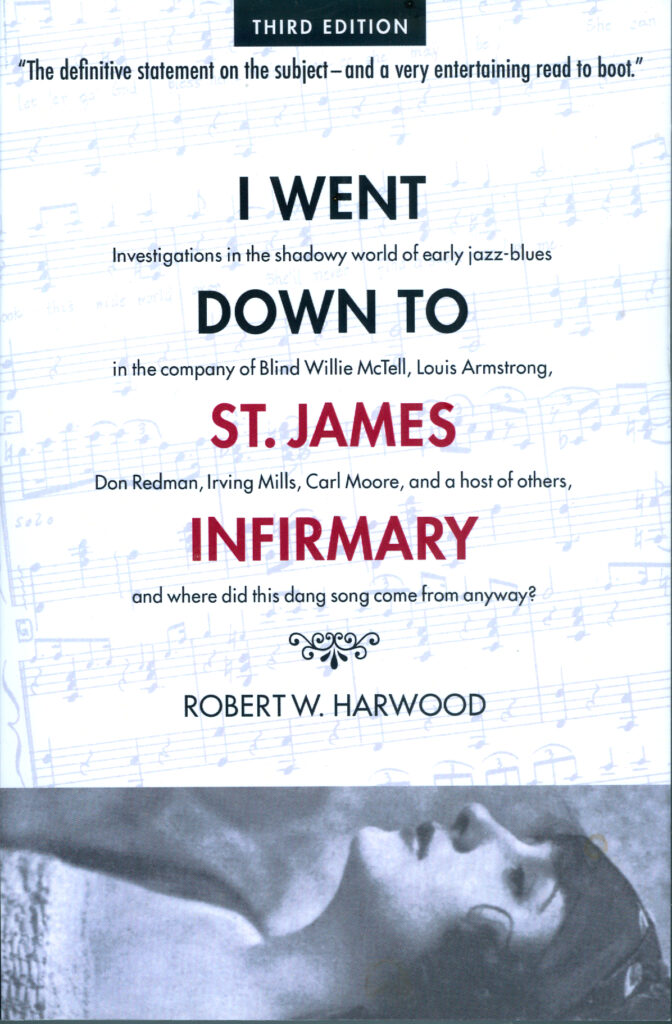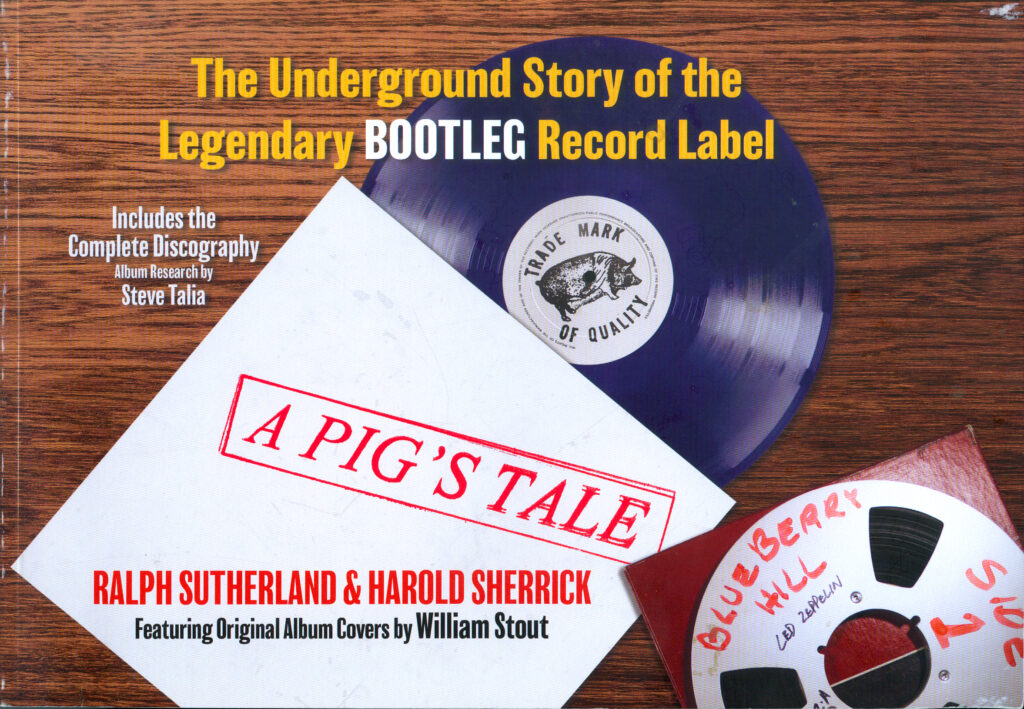I Went Down to St. James Infirmary
By Robert W. Harwood
A Pig’s Tale
By Ralph Sutherland and Harold Sherrick
At first glance, these two books have little in common other than being about popular music. The first traces the evolution of a classic blues song, the other the birth and life of a bootleg record company. In the end though, they both involve the quirks of American copyright law, especially as it applies (or doesn’t) to music and the chaos, confusion, and creativity that can lead to.

I Went Down to St. James Infirmary attempts to trace the roots of the classic blues song. It should be no surprise that tracing the origin of a folk song is a challenge, especially when one has to go back about a century to do so. Music is fluid; with every musician putting their own style on the songs they play, and perhaps turning them into something new in the process. Tearing all of that apart that takes some work; it becomes even more difficult when several people claim to have written the song, and even moreso when, as is the case with “St. James Infirmary,” more than one person had a copyright on it.
The state of the music business one hundred years ago further complicates the process. Recorded music was new and rare – at that time. That meant most musicians heard new songs from other musicians, in performance, and they often adapted a song they liked to their own style so they could perform it themselves. Without a “standard” version to model, it was much easier for a song to mutate.
The records which were released usually came out via a handful of small companies, and record keeping was thin; sometimes nonexistent. That meant a musician could record his version of a song, totally unaware that someone else had already recorded their version. For the most part, recorded music was a tiny part of the business.
The real money in the music business lay in publishing sheet music. Many households (middle class and above) had a piano, and bought sheet music so they could play their favorites at home. Only a handful owned record players, so the market for records was limited. Further, at that time, copyright only applied to published items. Sheet music was covered, but not recordings – further obscuring whatever paper trails might have existed. It also meant that, unless a song had been published, legally it was free for the taking.
Harwood presents these issues, but in a very haphazard way. This is the third version of this book, and at first he seems more interested in correcting the mistakes he made in the previous editions, wrongly attributing the song to various musicians who claimed to have written it, but didn’t. Unluckily, he never states clearly that this is what he is doing, he just dives into the corrections. Now, this is a mystery story of a sort, and sometime starting in the middle works well in a mystery, but not so much here. I spent the first half of the books scrambling to catch up. The book could really use an introduction, like the one above, laying out the issues in tracing the song, as well as the copyright issues.
The actual structure doesn’t help. He starts each chapter with a different song, some of which are connected to (and possibly the roots of) “St. James Infirmary,” but others are just a way of introducing relevant characters. Still, those songs are one key to the enigma he is trying to puzzle out. “St. James Infirmary” seems to be derived from a song called “Dyin’ Crapshooter’s Blues” (or some variation on that) which could be a variation on an English poem called “The Unfortunate Rake.” So many versions of the songs were recorded, and, as I indicated, various people claimed to be the first to play them.
Eventually, somebody published sheet music for the song, and therefore was able to claim copyright on it. In fact, two people did, publishing different arrangements. (Sort of like when pharmaceutical companies patent slight variations on the same molecule.) In the end, Irving Mills, who copyrighted the song under the name Joe Primrose, dominated the claims. As he was also the head of Mills Records, and, as soon as he had the song, released numerous versions by different musicians he had under contract, collecting royalties on all.
Theoretically those little record companies were paying songwriting royalties on the records they released, if there was a copyright on the song. Although, again, keeping financial records was iffy at best. But Mills got around this by releasing the song (multiple times) on his own record label.
One result of the copyright was there was now a standard version of the song, and most musicians who played it now followed that version (adding their own flavor, of course). Which is why “St. James Infirmary” is now considered a standard, and we know it when we hear it.
Now we jump forty years ahead, to The Pig’s Tale, the story of Trademark of Quality records, who released the very first bootleg records. (Why a pig’s tale? The Trademark of Quality logo was a pig.) Surely by then music copyright was different, right? Actually, no. Music recordings were not subject to copyright until 1972, when the first changes were made to the law since 1831(!). Any advancements on the law in the meantime were made on the state level. (Yes, every state has its own copyright law.) This left a wide grey area for the bootleggers to step into.
So when two young music fans acquired tapes of unreleased Bob Dylan songs (the book does not tell how they got them), they decided to release their own Bob Dylan album. They called it Great White Wonder, packaged it in a plain white jacket, and hand sold it to record stores around L.A. It was a big hit. Inspired by this success, they then smuggled recording equipment into six Rolling Stones concerts, released the best recordings as LIVEr Then You’ll Ever Be, and the Trademark of Quality label was in business.
They immediately inspired others to do the same thing, and bootleg records became a major factor in the music scene of the 1970s, at least for those fanatic enough to seek them out. Today, when you can go to a concert on Friday, and watch videos of that very concert on Sunday, it is hard to appreciate how exciting, fun, and even vital bootlegs were. When LIVEr was released, the only live Stones album was a weak excuse from 1966. Record companies seemed unaware of the demand for live albums; plus the technology to capture a good live recording barely existed. It doesn’t seem like a coincidence that shortly after bootlegs appeared, there was a surge of live albums (some, like Get Yer Ya-Yas Out from the Rolling Stones, and CSNY’s Four Way Street were released, at least partially, to compete with bootlegs).
Bootlegs were an important part of my record buying experience, especially in my college days. A combination of curiosity and a love of the energy of live performances drew me to them, and they were readily available in the small record stores of the college town.

This book clearly claims that what they were doing was perfectly legal, although that may or may not be true. In any event, record labels and artists were not pleased. The book doesn’t really delve into the legal issues, aside from reprinting several newspaper articles advocating the industry viewpoint. Despite the claims that nothing illegal was done, there are numerous episodes in the book of the participants in TMQ avoiding contact with the authorities. Even today most of the main characters are identified with aliases, including the main man behind the label, who is only identified as “The Pigman.”
But A Pig’s Tale is not all that concerned with these issues. It is primarily a celebration of TMQ, with anecdotes about many of the recordings, and the conflicts with other bootleggers. It is a also a catalog of every record they released, including song titles, cover art, and some information on where and when it was recorded. I found this fun, as I did own a number of bootlegs in my youth, including some of their releases.
Is there any lesson to be learned from these books, especially as concerns the interaction of copyright law and creativity? I think so. To put it bluntly, copyright stifles creativity. Of course, copyright is a necessary protection for the artist (although, as “St. James Infirmary” illustrates, it isn’t always used that way). But that doesn’t deny the many ways artistic freedom, meaning the freedom to mess with someone else’s creation, is hobbled by the laws. This is especially true in our age of sampling and cross-genre creating, but it was also true a hundred years ago, when musicians did their sampling and mixing the old-fashioned way.
It is questionable whether or not the “St. James Infirmary” we know today wouldn’t exist if musicians hadn’t felt free to mess around with songs which came their way. And while advances in recording equipment were surely a major reason for the burst of live albums in the early 1970s (including many albums now considered absolute classics), bootlegs unquestionably gave a push in that direction.
As a creative artist myself, I want it both ways. I want to earn what I deserve from my creations, but I also want others to feel free to be inspired by what I have created. (I have to chuckle a bit here, as my chosen forms of creativity, especially poetry, are not known for major financial benefits.)
Both of these books, I believe, demonstrate this freedom and its effects, even if that was not the intention of either. [G.Murray Thomas]